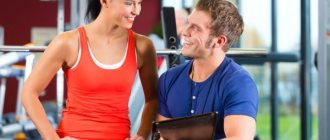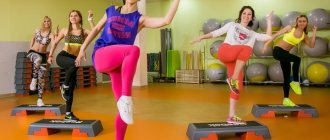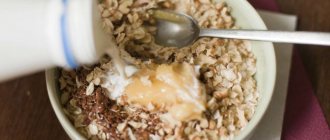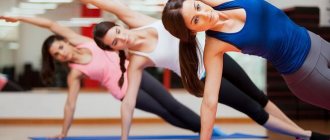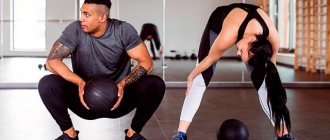The main differences between stretching and Pilates
Two modern trends in fitness - stretching and Pilates - help to achieve a graceful and slender figure with a flexible spine and ballet-like muscles. But they have a different history of origin and are built on different sets of physical exercises and principles. To understand the differences between stretching and Pilates, let's look at the features of each direction.
Features of Pilates
Pilates is a health-improving exercise system developed in the 1920s by German trainer Joseph Pilates for the rehabilitation of wounded soldiers and camp prisoners. It is aimed at improving the condition of the spine and joints.
The focus is on developing the core and abdominal muscles (called “core muscles” in Pilates), as well as stretching the spine.
Regular exercises can improve posture, coordination of movements, restore the physiologically correct curve of the spine and eliminate muscle tension.
Basic principles:
- all exercises of the complex are connected in one chain and are performed in a certain sequence;
- movements are smooth, without jerking;
- attention is concentrated on correct breathing and body position;
- constant tension of the muscles of the center - the abdominal muscles, pelvic floor and back.
Pilates is a dynamic type of physical activity, but the goal is not to perform as many repetitions as possible in a certain time - it is more important to do the exercises correctly, to feel the tension and work of the muscles as much as possible.
Features of stretching
The word stretching comes from the English. stretching - stretching. This is a set of exercises that develop body flexibility, joint mobility and ligaments. This trend of fitness does not have a creator or an exact date of birth. Swedish scientists first talked about the health benefits of stretching in the 50s of the 20th century, but it was known back in the days of Roman gladiators and ancient Greek Olympic athletes.
Stretching is based on alternating muscle tension and relaxation. Stretching exercises allow you to develop the flexibility of absolutely all muscles of the body and achieve mobility of all joints.
Basic principles:
- hold the muscle in a stretched position for 15-30 seconds, gradually increasing the time to one minute;
- Perform all movements smoothly; there should be no pain during exercise;
- increase loads gradually - the frequency, amplitude and intensity of movements increases from lesson to lesson;
- perform stretching exercises after a mandatory warm-up, which will increase the temperature of muscle tissue and prevent injury;
- training should be regular and systematic (at least 4-5 times a week).
Stretching is mainly a static type of physical activity (the exception is dynamic stretching, when springy movements are performed with full amplitude). In each lesson you need to strive for progress - to stretch a little more than last time.
Differences
Thus, a number of fundamental differences can be distinguished between the two types of fitness:
- Most of the exercises in Pilates are dynamic, while in stretching they are static;
- the main goal of Pilates is to correct spinal disorders, stretching is to increase flexibility and mobility of joints;
- when stretching, you do not need to focus on the “centre muscles”, as in Pilates, and control your breathing - the main thing is not to hold it while stretching the muscle;
- the Joseph Pilates system is based on a clear sequence of exercises, while greater freedom of movement is allowed in stretching;
- the emphasis in Pilates is on working the muscles of the core, abdominals and back; stretching involves all the muscles of the body;
- you can do stretching after cardio or strength training, use stretching exercises as a cool-down, Pilates is a full-fledged 40-60 minute training program (although some exercises can be used when doing other types of fitness, for example, planking);
- To progress and achieve goals, you need to stretch your muscles daily or 4-5 times a week; Pilates is enough to do every other day.
In stretching, unlike Pilates training, the help of a partner is often used to work out tight muscles that are difficult to stretch on your own. In addition, there are several types of stretching, which are based on different methods of tensing and relaxing muscles.
What is Pilates
Pilates is a very popular fitness trend . By exercising regularly, you can achieve impressive results. But you need to remember that Pilates is a complex system of exercises. Classes should be supervised by a trainer who will control breathing and monitor every movement. Only in this case will the training be not only effective, but also safe.
What benefits will Pilates give you?
During classes, all muscles of the body work. Each exercise involves several muscle groups at once. During training, even those muscles that are inactive in normal life work. Pilates does not increase muscle mass, but it has a healing and strengthening effect on the entire body. During exercise, all joints are subject to an impressive load, due to which flexibility develops. To avoid injury, it is important that the load is natural and increases gradually. Pilates can make the dream of a slim figure a reality. But it has a completely different effect than strength training or aerobics. Thanks to the exercises, health is improved, disrupted processes are restored in the body, and all internal organs return to their physiological position. By getting healthier, the body gets rid of everything that interferes with normal functioning, including fat deposits, toxins and waste.
Pilates specifically targets women's problem areas. By tightening the pelvic muscles and drawing in the abdomen, exercises help get rid of fat in the waist, buttocks, thighs and legs. Most Pilates exercises are done with a stretched spine. As a result, the back muscles and spine are relieved of stress, correct posture and natural grace return.
Who can do Pilates?
Anyone can practice, regardless of gender, age and physical fitness. Training will be of great benefit to those who want to improve muscle tone, but due to problems with the joints or spine cannot resort to strength training.
Pilates exercises help develop balance, the respiratory system, and prevent muscle spasms. Due to this, it is often used to restore physical shape after operations and illnesses.
Anyone who wants to gain grace and lightness should pay attention to Pilates or stretching. The program will not only teach you how to feel your body, but will also help you develop self-control and positive thinking. Do you want your body and mind to become one? Take up Pilates and see - achieving harmony is not difficult at all!
Similarities between stretching and Pilates
Despite the differences in principles, Pilates and stretching have much in common:
- the goal of the classes is not to lose weight or build muscle mass, but to increase the flexibility of the body, improve the condition of the musculoskeletal system, and improve health;
- training takes place under calm music, all exercises are performed smoothly, without sudden movements;
- you can practice in the gym with an instructor or at home - both complexes are easy to master on your own using video lessons or books;
- ideal for people with poor health or low levels of physical fitness, for those recovering from injuries or just entering the world of fitness;
- various exercises from both Pilates and stretching are included in the mandatory program for the training of professional athletes;
- no additional equipment is required for training - just a mat and 4 sq.m. free space;
- clothes should be comfortable, no shoes are needed at all - it is recommended to exercise barefoot;
- after classes there is no feeling of fatigue, only pleasant relaxation;
- if you perform all the exercises correctly and carefully listen to your feelings, the exercises will not lead to injuries;
- ideal for evening workouts.
You can do Pilates, like stretching, at any age; exercises of both complexes are suitable for adults and children, men and women.
What is the difference between Pilates and stretching?
- Pilates differs from stretching in that during Pilates classes the whole body is trained, and not individual muscle groups.
During Pilates classes, it is very important to constantly control your breathing and do all the exercises correctly. Pilates is a type of yoga, the only difference is that Pilates does not use meditation.
- Pilates, unlike stretching, develops strength, speed and flexibility. It is an excellent tool for improving posture, coordination of movements, developing dexterity and endurance.
If you regularly practice Pilates, all internal organs will begin to function better, breathing will normalize, and tension and stress will be relieved. Even pregnant women can do Pilates. A prerequisite in Pilates is the use of deep breathing. Only with its help will all muscles receive a sufficient amount of oxygen.
- Stretching can be done at home to maintain muscle elasticity, and beginners should learn Pilates only under the supervision of a qualified trainer.
Sources:
https://fitneszon.ru/fitnes/preimushhestva-pilatesa-i-stretchinga-dlya-zdorovya-i-gibkosti https://lifehacker.ru/chto-vybrat-dlya-rastyazhki-i-gibkosti/ https://doktorshen .ru/otlichie-pilates-ot-stretchinga/
The benefits of these types of fitness
Regular stretching classes, like Pilates, have a general healing effect on the body, which manifests itself in the coming weeks. It becomes easier to perform everyday movements, because the muscles of the whole body, spine and ligaments become more flexible and elastic, and coordination improves.
Both types of fitness have a rejuvenating effect on the body - the spine becomes more flexible and gradually returns to its physiologically correct position. Day after day, pain in the joints and back decreases, and the functioning of internal organs normalizes.
Despite the fact that the exercises and principles of Pilates and stretching are different, both types of fitness contribute to the harmonious development and strengthening of all systems and functions of the body:
- improve the condition of the spine;
- increase body flexibility and joint mobility;
- increase blood circulation;
- relieve insomnia and depression;
- increase immunity;
- normalize digestive functions;
- increase performance;
- balance the hormonal system;
- relieve problems in the sexual sphere;
- help make the figure more slender and graceful.
These healing effects can be guaranteed to be obtained if you regularly and correctly perform exercises from the Pilates or stretching complex.
Both types of fitness have a similar effect on the body, the only difference is that in the Joseph Pilates system the main emphasis is on improving the condition of the spine, but in addition to a healthy body, exercises from the complex allow you to believe in yourself, find harmony with yourself and the world around you.
Functional training
Functional training is a type of program in which exercises are performed aimed at developing balance and strengthening the muscular corset at the same time.
A special feature of the training is that the lesson includes exercises and body movements that are typical for us in everyday life (bending, turning, etc.). Due to the wide variety of functional training, this type of training is universal and will appeal to anyone!
Functional training provides: development and strengthening of muscle groups, both the outer muscle layer and the internal layer, development of balance, correct posture, flexibility, strength and endurance, good coordination.
Suitable for people with any level of initial fitness. Because Since this type of physical activity uses imitation of everyday movements, it can be practiced by almost all those who do not have general contraindications and heart arrhythmias or severe hypertension.
What is more effective for weight loss
Neither Pilates nor stretching will help you lose weight quickly, because the exercises are performed at a slow pace and without weights - there is no cardio or strength training that would contribute to intensive weight loss.
These types of fitness cannot be called energy-intensive. An hour of training burns:
- Pilates – maximum 200 kcal;
- stretching – no more than 150 kcal.
Weight will gradually decrease (especially if you watch your diet and limit your daily caloric intake), but this is rather a “side effect” of the exercise. Stretching muscles improves blood and lymph circulation in tissues, improves circulation and removal of excess fluid, thereby reducing body volume in problem areas. In addition, exercise normalizes digestion and speeds up metabolism, which also helps to get rid of extra pounds.
If you want to lose weight, it is better to choose stretching, but you must include cardio or strength exercises in your workout. Good stretching allows you to increase the range of exercise you perform and burn more calories.
What's better for your back?
There is no more beneficial form of fitness for the back than Pilates - a health system designed to treat diseases associated with functional disorders of the spine.
Pilates exercises:
- strengthens the back muscles;
- return the vertebrae to the physiologically correct position;
- improve blood circulation and metabolism in the intervertebral discs;
- correct posture.
Stretching, thanks to the development of spine flexibility, is also beneficial for the back. Stretching allows you to maintain a balance between tension and relaxation of the muscles that support the spinal column, make them more elastic, the vertebrae more mobile, and reduce the likelihood of lower back injuries during physical activity.
If you have back problems, you need to approach even Pilates and stretching exercises with caution. Supervision by the attending physician and sports instructor is desirable. Improper exercise technique can aggravate the situation.
Benefits of Stretching
Unlike Pilates, stretching is based on slow and dynamic springing exercises. They are replaced by ballistic swings with a wide range of movements, some of which are performed in pairs. All of them are aimed at stretching muscles and increasing the plasticity of the body. It is not important to follow principles such as: breathing, centering, focusing on isolated areas. The programs are designed to train the whole body and increase endurance. Each exercise takes 10 seconds to complete. The contraction and relaxation of muscles makes the fibers elastic, which allows you to effortlessly do the splits or spin on the pole.
In terms of effectiveness, the method is comparable to slow aerobics and yoga. The benefits of this direction are obvious to every coach. They are confident that even a one-time session increases blood circulation and metabolic processes in the muscles for several hours. By improving the elasticity of ligaments and tendons, techniques help athletes avoid injury. Lengthening muscle fibers increases the effect of fitness and models beautiful shapes. In addition, stretching in Pilates and stretching gives grace to your figure and movements, and lightness to your gait.
Stretching classes:
- relax, soothe, guarantee healthy sleep;
- eliminate radicular syndrome in the spinal column;
- stop the aging process;
- align the psycho-emotional state;
- increase resistance to stress;
- relieve pain of various origins;
- stimulate sexual function
.
Unlike Pilates, beginners can learn stretching at home using a video. But whatever system you choose, do not forget that working in a group with a coach is preferable at first.
Contraindications to classes
Stretching and Pilates are the most “harmless” types of fitness that can be practiced from three years old until old age. Even pregnant women and injured athletes are allowed to train.
However, there are a number of diseases in which exercise may cause more harm than good. These include:
- exacerbation of any chronic diseases, especially diseases of the musculoskeletal system: arthrosis, intervertebral hernias, protrusion, radiculitis;
- period of acute infectious diseases occurring with increasing temperature;
- severe diseases of the cardiovascular system;
- various body injuries (fractures, dislocations);
- post-operative condition (you can study after 6-12 months, depending on the complexity of the operation and health status).
Diseases such as bronchial asthma, varicose veins or a tendency to form blood clots are not a contraindication to Pilates or stretching, but require mandatory consultation with a doctor. It may be necessary to exclude any exercises from the standard complex and create an individual training plan.
What should you choose?
Since both areas of fitness are similar in the organization of training and health-improving effects, and have the same contraindications, the choice of direction largely depends on the goals pursued and personal preferences. When choosing between Pilates and stretching, you need to first ask yourself questions.
- Do I have problems with my spine?
- Are you ready to perform exercises in strict sequence and constantly control your breathing?
- Do I want to have a flexible body, healthy joints and stretch like a ballerina?
- Are you ready to train 5-6 times a week?
Having answered yes to the first 2 questions, you should make a choice in favor of Pilates. If the answer is yes to the last 2 questions, you can start stretching.
To visually compare the similarities and differences in the goals, principles and results of Pilates and stretching training, we will create a table.
| Criterion | Pilates | Stretching |
| The main goal of the classes | Improve posture and spine condition, find spiritual harmony | Increase body flexibility, stretch and lengthen muscles, increase joint mobility |
| Load nature | Dynamic | Static |
| Necessary equipment | Gymnastic mat, sometimes a training ring, fitball are used | Mat or yogamat, fitness bands can be used |
| Frequency of classes per week | 3-4 times | 5-7 times |
| Breathing tips | Strict breathing control: inhale deeply through the nose, exhale through the mouth. | Breathe through your nose without delay |
| Effectiveness for weight loss | Weight will decrease only with proper nutrition and in combination with an active lifestyle | You can only lose weight in combination with cardio exercises. |
| Energy consumption for 1 hour of training, kcal | 150-200 | 120-150 |
| Opportunity to independently master the complex and practice at home | You can easily master sets of exercises from books or video lessons and practice on your own at home, but for various pathologies of the musculoskeletal system, it is recommended to train under the supervision of a trainer in a fitness club | |
| The right time of day to exercise | Evening | |
| Effect of classes | Improving posture and spinal condition, improving health, increasing coordination of movements, gaining grace and self-confidence | Improving the condition of joints and spine, ballet muscles, slowing down age-related degenerative changes in the body |
| Who is it suitable for? | People with spinal diseases, physically undeveloped people, athletes recovering from injuries, lovers of leisurely, measured training | People who want to improve flexibility and mobility of joints, do the splits, have a figure like ballerinas or gymnasts, and get rid of cellulite |
It may be worth trying both Pilates and stretching to decide which direction is closer. Stretching elements can (and should) be included after cardio and strength training, as well as after Pilates classes. It’s good if the instructor, at least at the initial stage of training, talks about all the nuances of a particular direction and shows the correct technique for performing the exercises. The choice of type of fitness may also largely depend on this.
Pilates
Pilates is a type of program aimed at developing correct posture, as well as strengthening the inner layer of muscles.
Its distinctive feature is its absolute versatility and applicability.
Pilates gives: the skill of correct back position and posture, the development of flexibility and mobility of joints, the prevention of joint and spinal injuries and diseases.
Forms a strong muscle corset, develops proper breathing.
The advantages of this method are to strengthen the musculoskeletal system (joints, muscles, ligaments), especially the abdominals, improve coordination of movements, reduce back pain if present, and form a stereotype of proper breathing with minimal load on the spine. Pilates can be used by people of any gender, age, and with minor restrictions (for example, minimal stretching) during normal pregnancy and after childbirth.
Contraindications
- are common.
